ASRock Z77 OC Formula Review: Living In The Fast Lane
by Ian Cutress on January 15, 2013 1:00 PM EST- Posted in
- Motherboards
- ASRock
- Z77
- Overclocking
3D Movement Algorithm Test
The algorithms in 3DPM employ both uniform random number generation or normal distribution random number generation, and vary in various amounts of trigonometric operations, conditional statements, generation and rejection, fused operations, etc. The benchmark runs through six algorithms for a specified number of particles and steps, and calculates the speed of each algorithm, then sums them all for a final score. This is an example of a real world situation that a computational scientist may find themselves in, rather than a pure synthetic benchmark. The benchmark is also parallel between particles simulated, and we test the single thread performance as well as the multi-threaded performance.

In terms of single thread performance at stock, the ASRock ends up middle of the pack.
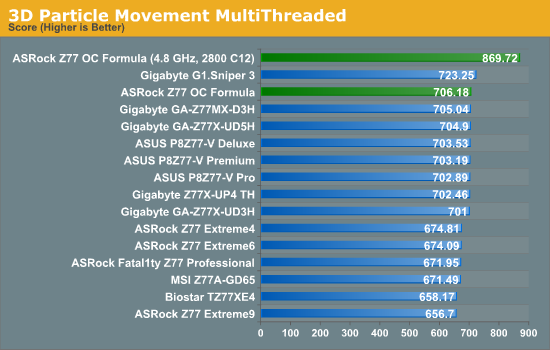
For our multi-threaded test, the ASRock is king of the pack of all the boards with MultiCore Acceleration. The MultiCore Plus used by the Gigabyte at the top for an extra multiplier still gives a pure MHz lead.
WinRAR x64 3.93 - link
With 64-bit WinRAR, we compress the set of files used in the USB speed tests. WinRAR x64 3.93 attempts to use multithreading when possible, and provides as a good test for when a system has variable threaded load. If a system has multiple speeds to invoke at different loading, the switching between those speeds will determine how well the system will do.
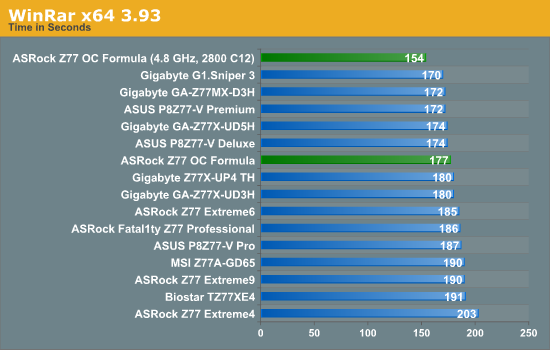
MultiCore Acceleration also plays a part in the variable loaded WinRAR, and the ability to run our memory kit at XMP helps over the weaker boards. There is still a little room for efficiency over the top end ASUS and Gigabyte boards.
FastStone Image Viewer 4.2 - link
FastStone Image Viewer is a free piece of software I have been using for quite a few years now. It allows quick viewing of flat images, as well as resizing, changing color depth, adding simple text or simple filters. It also has a bulk image conversion tool, which we use here. The software currently operates only in single-thread mode, which should change in later versions of the software. For this test, we convert a series of 170 files, of various resolutions, dimensions and types (of a total size of 163MB), all to the .gif format of 640x480 dimensions.
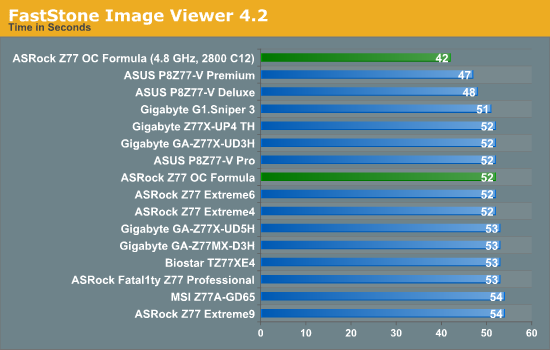
No real surprises in FastStone.
Xilisoft Video Converter
With XVC, users can convert any type of normal video to any compatible format for smartphones, tablets and other devices. By default, it uses all available threads on the system, and in the presence of appropriate graphics cards, can utilize CUDA for NVIDIA GPUs as well as AMD APP for AMD GPUs. For this test, we use a set of 32 HD videos, each lasting 30 seconds, and convert them from 1080p to an iPod H.264 video format using just the CPU. The time taken to convert these videos gives us our result.
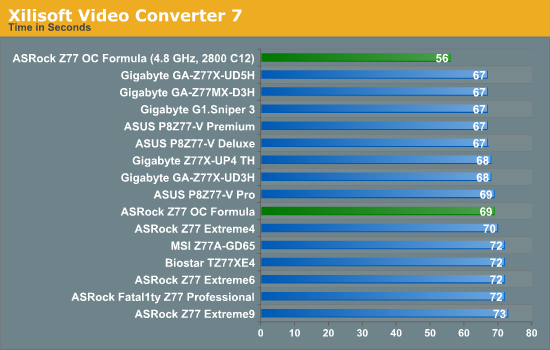
x264 HD Benchmark
The x264 HD Benchmark uses a common HD encoding tool to process an HD MPEG2 source at 1280x720 at 3963 Kbps. This test represents a standardized result which can be compared across other reviews, and is dependant on both CPU power and memory speed. The benchmark performs a 2-pass encode, and the results shown are the average of each pass performed four times.
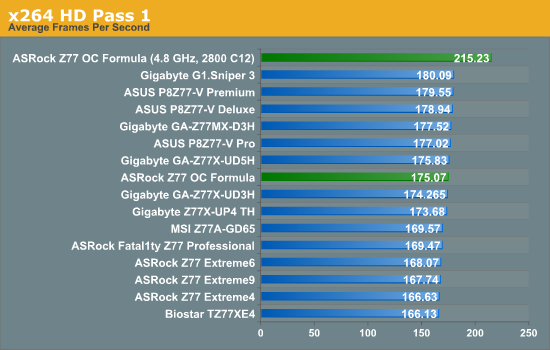











48 Comments
View All Comments
kmmatney - Thursday, January 17, 2013 - link
In the gaming benchmarks the ASRock Extreme4, $100 cheaper, gets the same result, even after the massive overclock on this board. While the overclocking is impressive, you can get a decent overclock with any cheap Z77 motherboard, and spend the difference in price on a better on a better video card, or the next grade of processor.Onus - Thursday, January 17, 2013 - link
I'd like to pass along my own experience with ASRock Customer Support. Cutting to the chase, it was entirely positive. I had obtained the review sample of an ASRock board from another site, which meant there was no warranty coverage. Unfortunately, the board died in the middle of a game. CPU temps were good, and I'd not [yet] had any reason to OC. Although I'd kept it at stock, it was a mini-ITX in a PC-Q08R, and the presence of a HD7870 in the build may have allowed something on the board to overheat, despite the pair of case fans. Anyway, I initiated an RMA request, fully explaining this situation, not trying to avoid their $50 service fee for out-of-warranty products. All correspondence was by email, and was handled quickly, with same or next day (if late) responses. I did pay the fee, but the RMA was handled quickly, and the new board is now just waiting for a brain (I used the original i5-3570K CPU in another build).watersb - Thursday, January 17, 2013 - link
Ian, you are a MOTHERBOARD MADMAN!!! I can't keep up, but I try anyway.Sincere THANKS for these recent reviews. Wow.
The Magpie - Friday, January 18, 2013 - link
I like this board. In fact I like ASRock more and more. I remember the old days when their entire lineup was silly looking, bad performing boards. Those days are gone now and that is great. But that is not the point of this comment.The point is to say that I'm feeling a bit offended by having to read through the same bloody lines, once at the very beginning, and again at the very end of the article. Great technical knowledge Ian, but have some kind of respect for yourself and your work, and don't copy\paste the same lines from the first to the last page. What happened, ran out of things to say? Embarrassing and outrageous for someone who takes the time to read through your entire piece.
waldojim42 - Sunday, January 20, 2013 - link
I see that you are finally testing for some idea of sound quality, and I am quite grateful, but why aren't we hammering on these companies over missing features here? I care about one thing and one thing only; Dolby Digital Live encoding. I don't see why I should be forced to by a $150 Creative labs POS just so I can use the fiber connection for my 5.1 audio.This is a feature that was available as far back as the Nvidia Nforce 2 for crying out loud! Why is this not standard on $200+ motherboards? It cannot be that difficult, and I am sure there are more than a few gamers out there that would be happy to see this.
As of right now, the ONLY motherboard on my radar is the Gigabyte Sniper 3. Sadly, they used a Creative chipset to get the job done, but at least it is built into the board.
Anand, could you possibly reach out to these manufacturers and get them to understand people want this? The worst part, is that it is quite obvious there is very little in licensing costs involved, if Creative is anything to go by ($5 to get DDL on your current product!) and that is money well spent.
IanCutress - Friday, January 25, 2013 - link
Would you be interested in B75 with a Creative chip? Drop me an email with specifics. I'm not an audio nut (tone deaf too), but I can pass on some info :)Ian
jimmyzaas - Tuesday, January 22, 2013 - link
I was very close to picking up the Z77 OC Formula. The only thing that I didn't like was that tiny fan for the VRM. I've had an Abit board before with the southbridge fan and about 2 years in, it started to get louder and louder until all you hear is grinding noise. Issue was that whole assembly was proprietary and replacing the fan means replacing the entire heatsink. Since then, I've vowed not to get any mobo that needed a fan of any kind.My question is.. do the VRMs get that hot that they require active cooling? I mean no other boards, including that monster Gigabyte UD7 needed fans? Or is it just for show.. if so, it is a retarded move. Second question, is it like a standard 40mm fan that can be replaced easily? If not, is the board still stable with NO fan attached.
To the poster above wondering about the Sniper board.. I have it and that audio is the best I've ever had from a motherboard. I have a Gigabyte board with Realtek 889 audio and the Core3D just crushes it in every way. Now I haven't heard Realtek 898 on my sound system, so I can't compare.. but I'm really blown away by the sound. Not really impressed by Killer NIC though.
IanCutress - Friday, January 25, 2013 - link
The VRM fan is predominantly there in case (a) low air flow situation, like a closed-loop liquid cooler, or (b) hot ambient climate. You are perfectly justified in taking the connector out if neither of those apply to you. VRMs during normal stock usage are easily cooled by cross air flow, but as you start hitting 4.8 GHz+, they might start kicking out some heat if you are constantly hammering the CPU with loads. A small 40mm fan probably doesn't do much in that case, but it does something.With regard to the UP7, they use IR3550s, which are designed to pump out less heat for the same power - and there's 32 of them, so the heat generated is spread around such that the long extended heatsink can take care of everything.
Ian